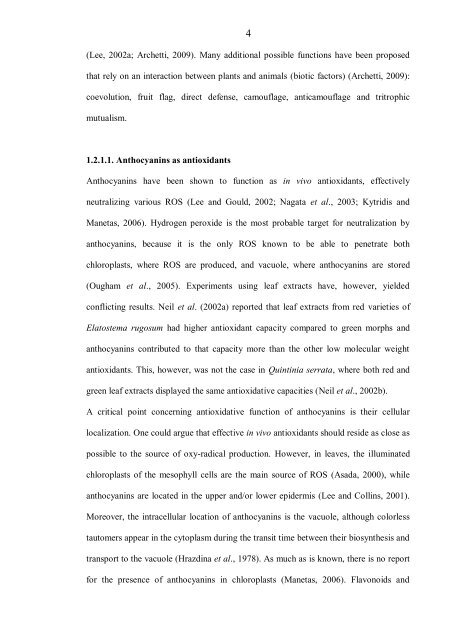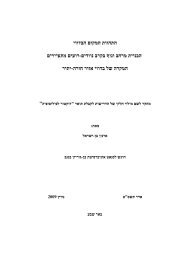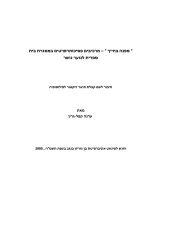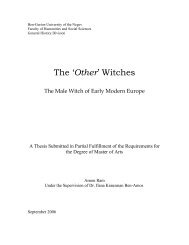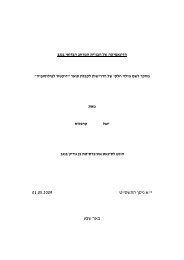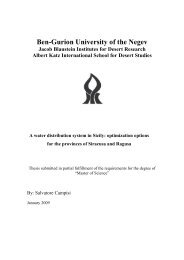Ben-Gurion University of the Negev
Ben-Gurion University of the Negev
Ben-Gurion University of the Negev
Create successful ePaper yourself
Turn your PDF publications into a flip-book with our unique Google optimized e-Paper software.
4<br />
(Lee, 2002a; Archetti, 2009). Many additional possible functions have been proposed<br />
that rely on an interaction between plants and animals (biotic factors) (Archetti, 2009):<br />
coevolution, fruit flag, direct defense, camouflage, anticamouflage and tritrophic<br />
mutualism.<br />
1.2.1.1. Anthocyanins as antioxidants<br />
Anthocyanins have been shown to function as in vivo antioxidants, effectively<br />
neutralizing various ROS (Lee and Gould, 2002; Nagata et al., 2003; Kytridis and<br />
Manetas, 2006). Hydrogen peroxide is <strong>the</strong> most probable target for neutralization by<br />
anthocyanins, because it is <strong>the</strong> only ROS known to be able to penetrate both<br />
chloroplasts, where ROS are produced, and vacuole, where anthocyanins are stored<br />
(Ougham et al., 2005). Experiments using leaf extracts have, however, yielded<br />
conflicting results. Neil et al. (2002a) reported that leaf extracts from red varieties <strong>of</strong><br />
Elatostema rugosum had higher antioxidant capacity compared to green morphs and<br />
anthocyanins contributed to that capacity more than <strong>the</strong> o<strong>the</strong>r low molecular weight<br />
antioxidants. This, however, was not <strong>the</strong> case in Quintinia serrata, where both red and<br />
green leaf extracts displayed <strong>the</strong> same antioxidative capacities (Neil et al., 2002b).<br />
A critical point concerning antioxidative function <strong>of</strong> anthocyanins is <strong>the</strong>ir cellular<br />
localization. One could argue that effective in vivo antioxidants should reside as close as<br />
possible to <strong>the</strong> source <strong>of</strong> oxy-radical production. However, in leaves, <strong>the</strong> illuminated<br />
chloroplasts <strong>of</strong> <strong>the</strong> mesophyll cells are <strong>the</strong> main source <strong>of</strong> ROS (Asada, 2000), while<br />
anthocyanins are located in <strong>the</strong> upper and/or lower epidermis (Lee and Collins, 2001).<br />
Moreover, <strong>the</strong> intracellular location <strong>of</strong> anthocyanins is <strong>the</strong> vacuole, although colorless<br />
tautomers appear in <strong>the</strong> cytoplasm during <strong>the</strong> transit time between <strong>the</strong>ir biosyn<strong>the</strong>sis and<br />
transport to <strong>the</strong> vacuole (Hrazdina et al., 1978). As much as is known, <strong>the</strong>re is no report<br />
for <strong>the</strong> presence <strong>of</strong> anthocyanins in chloroplasts (Manetas, 2006). Flavonoids and


